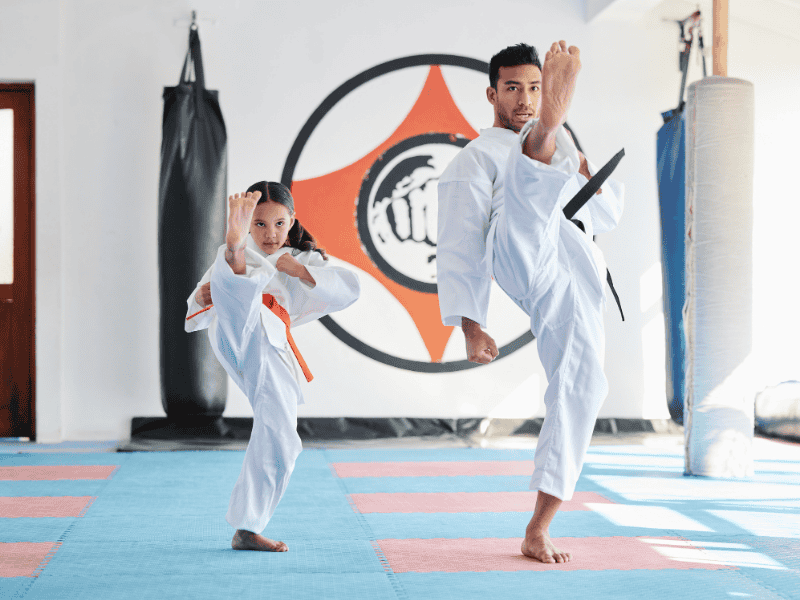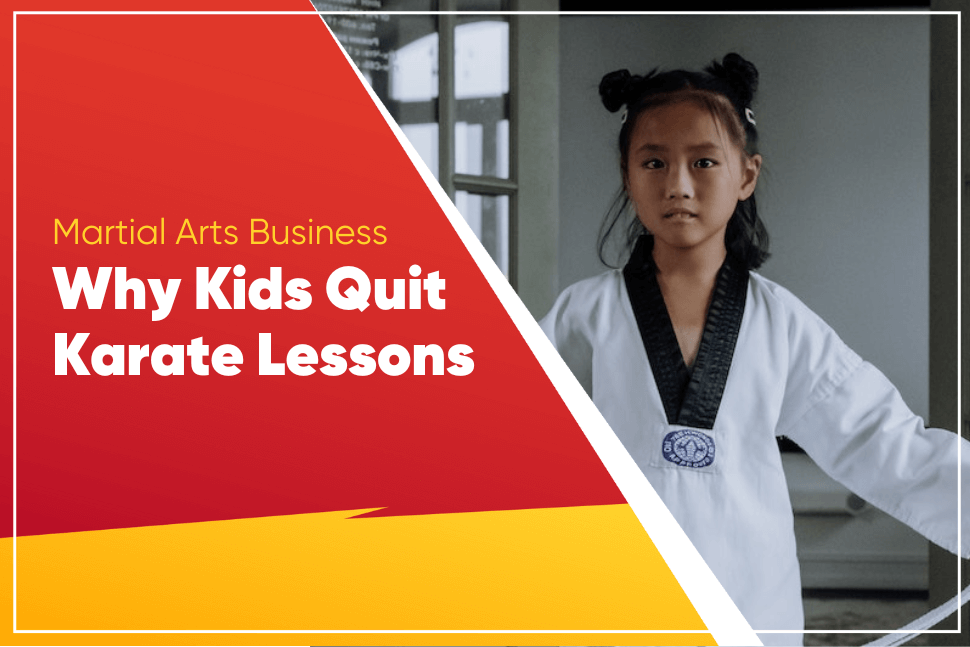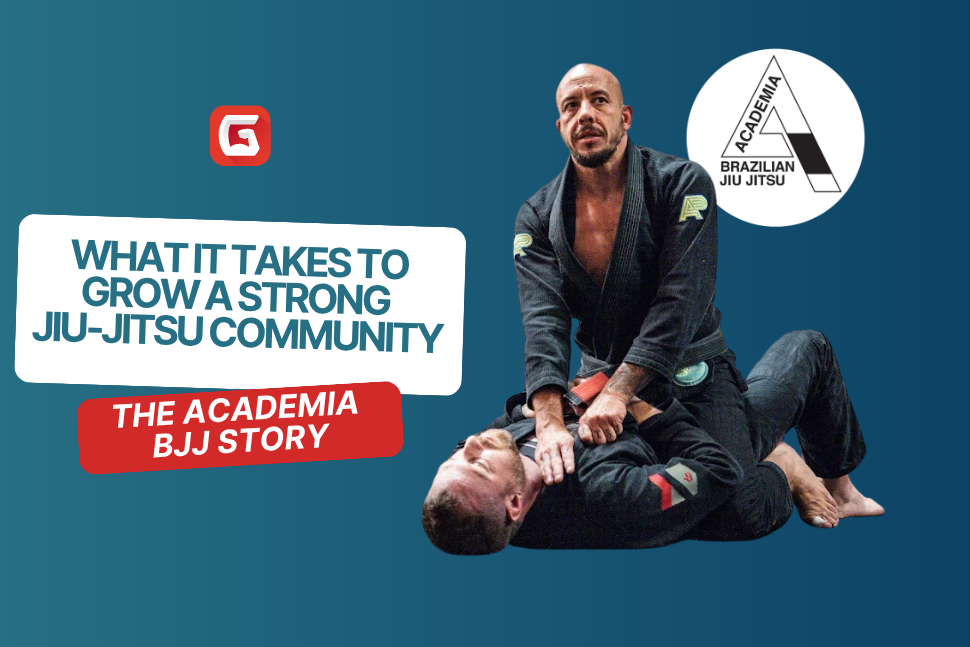Member turnover in karate schools is brutal, sometimes even higher than the already-high churn rates in the fitness industry in general. This creates a lead generation “rate race” to constantly and frantically generate large volumes of new leads to replace ex-members.
Karate dojos often rely on kids to pay the bills. Parents are used to signing kids up for karate every school year, but they aren’t accustomed to the commitment it requires to bring a kid from white belt to black belt. As a result, kids karate programs tend to have concerningly high churn rates the same as adult programs.
With these turnover numbers, it’s no wonder most karate schools close up shop within the first 2 years of opening.
Healthy lead generation will always be necessary to thrive in the martial arts business, but good retention strategies are necessary for growth.
And to effectively implement retention strategies in your dojo, you need to first understand why students quit karate. And that’s what we’re going to explore in the following article.
Lack of Connection with the Instructor
Some karate instructors just aren’t good with children. They don’t know how to talk to them, or run exciting classes, or motivate them, or more importantly, listen to them. This is one of the most overlooked things when considering kids karate instructors.
These defects often lead to high turnover in children’s karate programs:
- Inattentive
- Severe/loud
- Grim
- Inflexible
- Low energy
- Critical
Being too critical is probably the biggest mistake that kids instructors make. They make too many corrections, expect too much, and sometimes resort to exasperation or even yelling to try and motivate children to “try harder” or perform better.
This is not the way to go. It flusters children and makes them feel like they can’t do anything right. Eventually, they’ll quit because they feel like they aren’t good at karate and they dread the instructor’s critical eye. This plays into being too grim or inflexible.
Also, what you think privately about students will likely affect your behavior toward them even if you think you’re hiding it. And kids are very good at picking up on those signals.
The second biggest reason why kids don’t connect with instructors is communication. One of my pet peeves with martial arts instructors is their refusal to genuinely listen to what their little students say to them.

I recall a story from my time as a kids’ BJJ coach that illustrates this:
Coach had a strange way of talking to the children. He didn’t listen to anything they said – he seemed to speak as if on the same script, and hurried each conversation to a close.
I never liked this. I remember one little girl was excited to share some news with him after class. After some jarring back and forth, my coach had failed to hear or respond to anything she had said.
Instead, he seemed to be trying to guess what she was saying before she said it, but it didn’t make any sense, and the consternation became visible on her face. Finally, he curtailed it and shooed her away to play with the others until her parents arrived to pick her up.
As she walked back toward the other kids, her face – her whole body – seemed to deflate. I felt for her. I’d seen instructors interact with kids like this time and again.
And time and again, these instructors had trouble getting their students to listen to them properly. Kids desperately want a real connection, to share something of themselves, but they remain unheard – lost in the noise of surface level “grownup” communication.
Finally, instructors need to have infectious, positive energy. It doesn’t matter if you’re low energy outside of class, you’ve got to muster it for teaching karate.
And you can certainly do it, even if you’re an “introvert.” I tend to be a more reserved person in everyday life, but when it was time to teach my class, I switched a switch and the energy flowed out. As a result, I facilitated explosive classes that were even entertaining to onlookers.
Lack of Connection with Classmates
One of the main draws of karate lessons is the fact it teaches life skills. A major part of that is improving a child’s social ability.
Karate should be a safe place for kids to try prosocial behaviors and practicing making and maintaining friendships. If that’s not happening, both your students and their parents will not believe in the value…and the culture in your school will suffer as a result.
Your karate school is a community, so it should feel like one. In addition to fostering a friendly, positive, fraternal environment among classmates, you should also be hosting Parents’ Night Out, movie nights, pizza parties, anniversary parties, and holiday events as regularly as you can manage them.
Human beings of all ages crave connection. As a karate instructor, it’s your job to create a community in your dojo that’s welcoming, warm, and a part of which every child longs to be. Do your part to make introductions, encourage kids to talk to different people inside class, and provide opportunities for collaboration and fun.
Lack of Parental Support
When you sign children up for karate classes, you sign their parents up for classes, too. But karate school owners often neglect the latter.
The first problem is that parents do not reinforce the lessons from karate at home, so the importance of karate is diminished to both children and their parents. Secondly, parents fail to establish a routine to encourage interest in and ultimately attendance of karate lessons.
Parents have also become accustomed to pacifying their children in exchange for manageable behavior. As a result, they are increasingly less likely to encourage their children to attend karate lessons if their children decide they don’t want to go anymore.
“Overbooking” is a less obvious way that parents don’t support their kids with karate practice, too. The kids are at school all day, and they’re doing chess club, and gymnastics, and softball, and soccer practice, and debate club, and on and on.
This is very mentally taxing. You can’t expect kids to be active in these activities every day, week in and week out, plus school and homework, and not feel like quitting something. And because most other activities are more closely connected to school, karate is usually the thing that has to give.
These are things that you have to address in new member onboarding, and they’ll be things you’ll have to address again as necessary throughout the course of each student’s training at your dojo.
Recruit and educate the parents of your students: it’s a powerful retention strategy (even in hard times).
Boredom
After a while, the typical karate program gets pretty boring. Memorizing the same forms, the same one steps, the same 6-12 self-defense sets.
Some programs try to stave this off by adding even more curriculum to memorize, weapon sets and forms, board breaking, and creative forms. But at the end of the day, this just creates more memory-based things to do, and that’s more of the same, and more importantly, it’s overwhelming.
While conventional sports programs have their turnover, kids will regularly stick with those sports for 2, 3, even 4 years before doing something else. Not so in martial arts.
There is no intrinsically fun activity toward which the drudgery of karate practice is promising to help a child become better at. There is no fun on the horizon. There is nothing enjoyable in and of itself, like a game.
This happens way before black belt, but it explains why even among kids who make it to black belt the quitting rate remains high.
And I’m going to catch some flack for this, but traditional karate programs just aren’t good – unless you want to specifically master forms. Most kids don’t.
Traditional karate instructors think that the way they teach is more conducive to serious skill development, but the science of skill acquisition shows that that simply isn’t true. The hard truth is simply that instructors teach this way purely for tradition’s sake, not the sake of their students’ learning or enjoyment.
My passion for taekwondo as a kid brought me through nearly five straight years of practice and to a 3rd degree black belt. Having reached that level, there was nothing for me to do but repeat the same material over and over again for 3 years until I could test for my 4th dan.
In the last 10-15 years, there’s been a big push to dress up traditional programs with pattern breaks and more games, but the fact remains that it’s still a memory-based, aesthetics-centered exercise with very little connection to anything dynamic or sporty.
I’ll address how to make your programs more dynamic in the next section. If you want to learn how to make better lessons, check out the modern section of our article on martial arts lesson planning.
Fatigue & Burnout
I mentioned in the previous section that karate programs are often cluttered with bloated syllabi of things to memorize and recall (forms, one steps, self-defense routines, etc.). These things are fun and exhilarating at first because they’re new, but after some time, the novelty wears off.
Why? Because kids have school work and piano lessons and a dozen other things they need to memorize and recall and be graded on. After the honeymoon phase fades, karate just feels like school all over again. No kid wants to spend six to eight hours at school and then go straight to more schoolwork.
Except for the select few who want to be competitive athletes at performing forms, memorizing katas and one steps is boring. It’s not interesting. It’s not challenging in the way a game of basketball or soccer is.
Like I said in the previous section, there is no fun activity toward which the drudgery of karate practice is promising to move a child. It’s just slogging it out for slogging’s sake.
Kids are also chronically overbooked, and that’s not their fault. And if their parents won’t adjust their schedules in a way favorable to karate training, then you’ve just got to offer something so incredibly fun to do that kids still look forward to it after a long week of activities and school.
It’s for these reasons I recommend safely and gradually transitioning kids into a sport karate program. Sport karate is challenging, active, safe, and always fun. And for more competitive children, tournament opportunities are nearly boundless.
If you just can’t do that, embed more karate-flavored games into your classes. Instead of having kids punching and kicking the air for so much of class, teach them different ways they can interact with partners using pads and paddles.
Rather than have kids waiting in line to kick shields or hit the bag, have them pair up with each other and move around. And if you must use a bag, try using multiple stations with other activities so that kids are not wasting precious class time standing in line (and have less opportunity to goof off).
At any rate, don’t add loads more curriculum to memorize or waste class time punching the air or waiting in lines. You don’t have that much time with the kids, and they want to have fun. Use the time wisely with partner exercises, games, and sport programming.
Conclusion
Member turnover in karate schools can be high, creating a need for constant lead generation to replace ex-members. This is particularly true for kids karate programs, as parents may not fully understand the commitment required to bring a child from white belt to black belt.
Despite this, good retention strategies are necessary for growth in the martial arts business. To implement them, however, you need to understand the major reasons why karate kids quit in the first place:
- Lack of connection to the Instructor
- Lack of connection with the Class
- Lack of Parental Support
- Boredom
- Fatigue & Burnout
Address these in yourself, parents, and/or program design, and you’re well on your way to a healthy retention and consequently a healthy membership count in your karate school.
 Gym Owner Statistics: The State of Gyms, Member Trends, and Usage Data
Gym Owner Statistics: The State of Gyms, Member Trends, and Usage Data




 EN (English)
EN (English)
 JA (日本語)
JA (日本語)